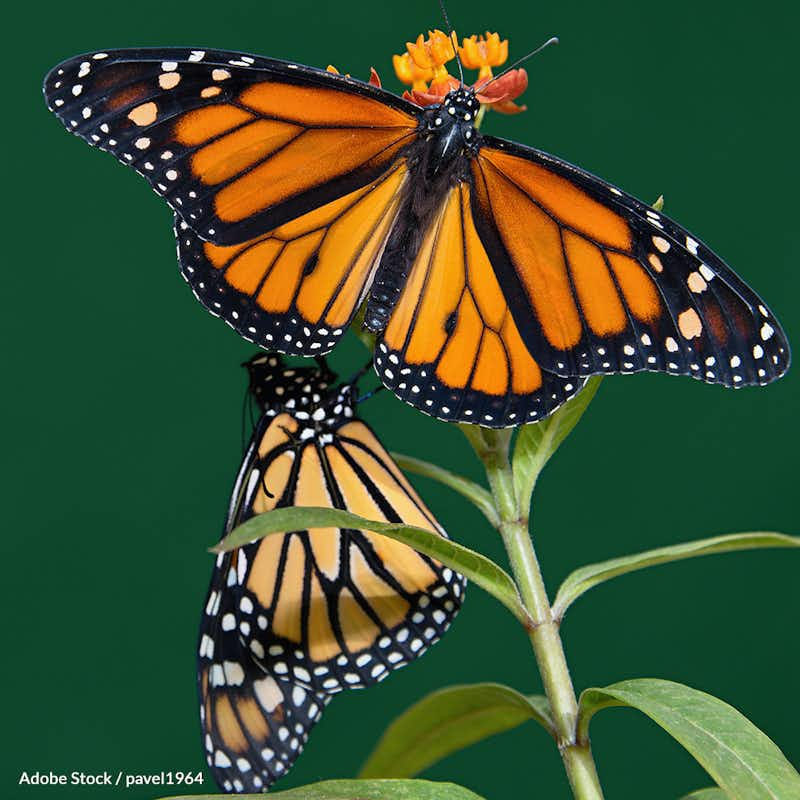Save the Monarch Butterfly from Extinction
65,317 signatures toward our 75,000 Goal
Sponsor: The Rainforest Site
The U.S. Fish & Wildlife Service admits that the Monarch Butterfly is endangered. Let's make it official!

The monarch butterfly is facing an uncertain future, and if it is not soon reclassified as endangered by the U.S. Fish and Wildlife Service, it may not have a future at all.
The Xerces Society's annual winter count of the monarchs recorded fewer than 2,000 butterflies along the California coast1, while previous years have tallied tens of thousands. Researchers were stunned by the disappearance of these insects, which have historically covered pines during their migration south from Marin County in Northern California to San Diego, before moving on to Mexico.
On the other side of the Rocky Mountains, another group of monarchs that takes the eastern route from Canada to Mexico, is now about 80% smaller than what it was in the mid-1990s2.
One reason for the monarch butterfly's disappearance is the destruction of milkweed habitat along their route across the U.S. Expanding housing developments and the proliferations of pesticides and herbicides coupled with climate change and wildfires have disrupted this 3,000-mile stretch of wildflower-lined butterfly highway3.
The Xerces Society and the University of Nevada, Reno collaborated on a study of milkweed plants that found pesticides in conventional and organic farms, wildlife refuges, and urban areas; basically every site they sampled. Further, many of the compounds they isolated were found to be harmful to Monarch larvae4.
In 2017, Washington State University researchers predicted that the monarch population only had a few years left once its numbers dropped below 30,0005.
It's possible we may not see the monarchs travel this way much longer.
Reclassifying the monarch butterfly as an endangered species would support conservation efforts and give these insects the federal protections they need to bounce back from the brink. However, despite meeting the U.S. Fish and Wildlife Service's criteria for an "endangered" species, the federal government decided against listing the monarch butterfly as either threatened or endangered in December 20206.
"The U.S. Fish and Wildlife Service agrees that monarchs are threatened with extinction," said Sarina Jepsen, director of endangered species at the Xerces Society conservation group7. "However, this decision does not yet provide the protection that monarchs, and especially the western population, so desperately need to recover."
The monarch butterfly is in urgent need of protection. Sign the petition below and join thousands of others in demanding the U.S. Fish and Wildlife Service and the Department of the Interior amend the Lists of Endangered and Threatened Wildlife and Plants to include the monarch butterfly!
- Emma Pelton, Xerces Society (30 November 2020), "Monarch Population in California Spirals to Another Record Low."
- Associated Press (20 January 2021), "Monarch butterfly population moves closer to extinction."
- Jim Daley (21 March 2019), "Study on Weed Killers and Monarch Butterflies Spurs Ecological Flap."
- Sarah Hoyle & Aimée Code, Xerces Society (4 June 2020), "Science Notes: How Pesticide Sampling Can Help Restore Imperiled Western Monarchs."
- Cheryl B. Schultz, Leone M. Brown, Emma Pelton, Elizabeth E. Crone, Biological Conversation (17 March 2017), "Citizen science monitoring demonstrates dramatic declines of monarch butterflies in western North America."
- U.S. Fish and Wildlife Service (15 December 2020), "Assessing the status of the monarch butterfly."
- Matthew Shepherd, Xerces Society (15 December 2020), "Much-Needed Federal Protection for America's Beloved Monarch Butterfly Warranted, but Precluded."
The Petition:
To the U.S. Fish and Wildlife Service and Department of the Interior,
The monarch butterfly is facing extinction, as the USFWS has already declared, and if it is not immediately reclassified as an endangered species we will lose this majestic species forever.
Recent counts of monarchs show eastern populations have been reduced in size by 80% since the mid-1990s, and western monarchs are even worse off. The Xerces Society's annual winter count of the monarchs recorded fewer than 2,000 butterflies along the California coast, while previous years have tallied tens of thousands.
Washington State University researchers predicted in 2017 that the monarch population only had a few years left once its numbers dropped below 30,000.
If monarch butterflies are not granted the federal protections they deserve, their extinction will come even sooner.
I demand you amend the Lists of Endangered and Threatened Wildlife and Plants to include the monarch butterfly.
Sincerely,
Updates:
The Mexican government reported the lowest recorded levels of Monarchs after conducting their annual census in the butterflies' winter home. With Monarchs occupying only 2.94 acres of forest, the latest figures mark a 59 percent decline from just two years ago, likely exacerbated by droughts and high temperatures in the American Midwest, where the Monarch seeks food in the summer. Urge the EPA to intervene before it's too late!
 Welcome Back! Log In to Continue
Welcome Back! Log In to Continue